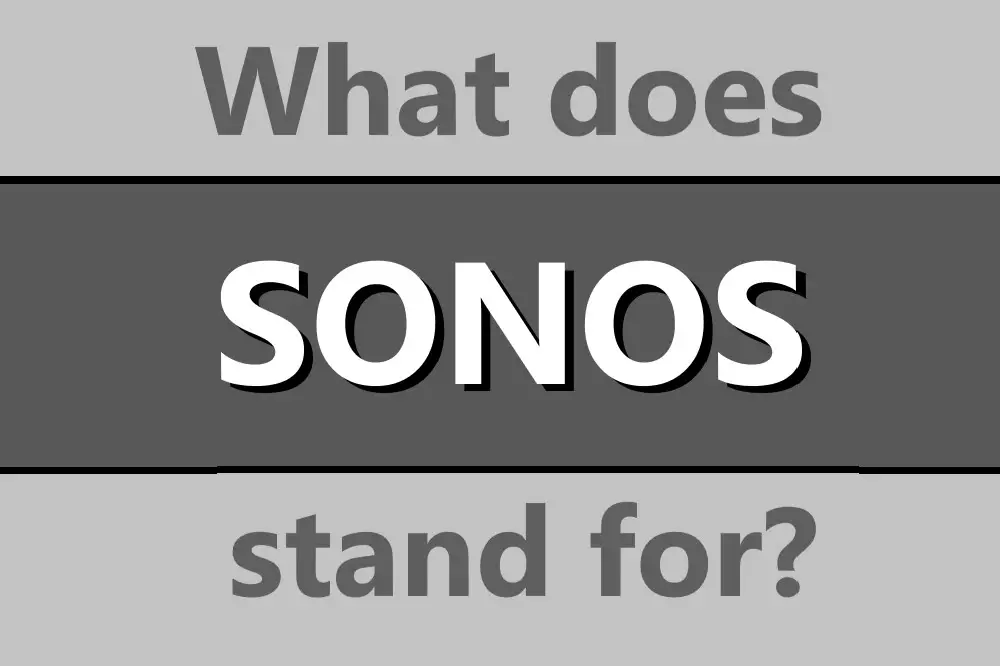Sonos has taken the wireless speaker market by storm, and it seems to have all the best aspects: great device compatibility, ease of use, stylish design, and a catchy name. But what does Sonos mean and where is it from?
Sonos is a word created for the product and is a combination of some Latin root words as well as the initialism OS. It is not a reference to ancient Roman or Greek gods as is often thought.

I’ll take you through the history behind the word and why it was chosen to represent this product as well as some other interesting facts about the process.
Table of Contents
What Does Sonos Stand For?
There are two answers to this, as confirmed by the company responsible for the branding and marketing strategy behind Sonos, Lexicon.
Sonos comes from the Latin root word Sonus which means sonic and sound. Second, Sonos can be thought of as two separate parts, son and os: an operating system for sound. Son is part of the Latin mentioned word, and OS is an initialism that stands for the operating system.
As Sonos was trying to fill a perceived gap in the market by making the task of having music easily accessible and audible in all rooms of a house without having to drill holes, snake cables, or have massive speakers everywhere, they wanted a name to represent this.
This was also before services like iTunes and Spotify made streaming music legally and wirelessly as easy as it is now, and so while the concept of Sonos may seem obvious now, in the early 2000s the environment was very different.
The need to have some kind of centralized controller or operating system was seen as a vital component to have the product work properly, although as complementary services grew in popularity and spread, the need for this has also dissipated.
Who Gave Sonos Its Name?
Sonos is the result of the marketing and brand name development company Lexicon, which is famous for such brand names as Pentium, for Intel; Swiffer, for Procter & Gamble; PowerBook, for Apple; Dasani, for Coca-Cola, and many more.
The exact process of how they came to such a name is a company secret, but whoever brainstormed the idea likely has some strong Latin knowledge or spent some time looking up root words and their etymologies.
How Did Sonos Get Its Name?
Lexicon’s guiding principle is that short words are best, but with millions of trademarks, it can be hard to find a word of four- or five letters that are still available to be used.
Sonos, being a compact palindrome, is both memorable and conveys the ‘operating system for sound’ concept beautifully.
There has been criticism of the strange names that tech companies from Silicon Valley come up with, and their predictable patterns that just scream, ‘Yeh we paid a lot of cash to some marketing firm for this’.
For example, it seems that every other name is just a suffix like -ly or -ify to a word (Spotify, Grammarly), dropping a vowel (Flickr, Scribd), or picking something with a mystical or magical feel (Shazam, Zoom).
There has been some interesting research on the topic and there is a sound basis for making certain brand names spelled the way they are due to them sticking in people’s minds for longer, more intuitive spelling and other psychological explanations.
If they had their time again, would Sonos still pick Sonos? Hard to say, but with all the controversy around Theranos, I have the feeling that companies may be avoiding the ‘-nos’ ending for quite some time.
Sonos Is an Ambigram
A palindrome reads the same backward and forwards and is similar but distinct from ambigrams. Some common examples include civic, kayak, level, noon, racecar, tenet, and wow.
Ambigrams are a relatively recent concept and appear as visually symmetrical words.
This means you can flip them 180 degrees and they remain unchanged or reveal another meaning or word.
There are half-turn ambigrams that can be read upside down as they boast rotational symmetry through 180 degrees.
There can also be mirror ambigrams that have axial symmetry and so are able to display properly in mirrors and other reflective surfaces.
The word was coined in 1983 by Douglas Hofstadter, who is quoted as saying, ‘ambigram is a visual pun of a special kind: a calligraphic design having two or more (clear) interpretations as written words’.
Indeed, the link between palindromes and ambigrams is so strong, that ambigrams are themselves referred to as graphic palindromes.
Thus Sonos can be rotated 180 degrees and still be read perfectly well. Some other interesting examples include the word OHIO when written in capitals and can be read perfectly well in both vertical and horizontal orientations with a 90-degree turn.
As ambigrams rely heavily on how they are written, a list of examples is not so easy to represent non-visually, but there are many famous company logos that have ambigrams in them including Sun Microsystems and book titles like Dan Brown’s Angels & Demons.
Sonos Is Not a Greek God
Sonos indeed does sound like the gods of ancient Rome or Greece but has nothing to do with either. The concept of a wireless speaker certainly could elicit feelings of divinity through the disembodied voice, but it appears to have not much to do with the branding.
There is a similar word, Somnus, which is from Roman mythology and is known as the personification of sleep. Somnus was the brother of death (Mors) and can be seen in English today in words like insomnia.
The link between Latin and Ancient Rome is a strong one as it was the language spoken across the Roman Empire.
In Greek, the word for sleep is Hypnos while Greek for sound is Echo, which refers to a Nymph. Nymphs are minor female nature deities distinct from Goddesses. Clearly, there is not much link here to be found back to Sonos.



